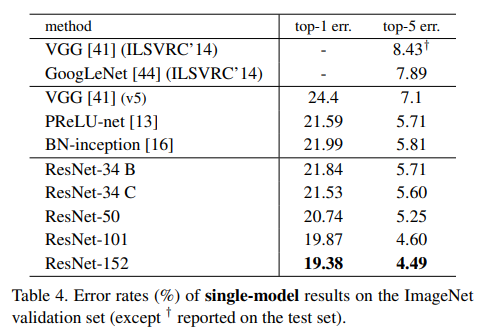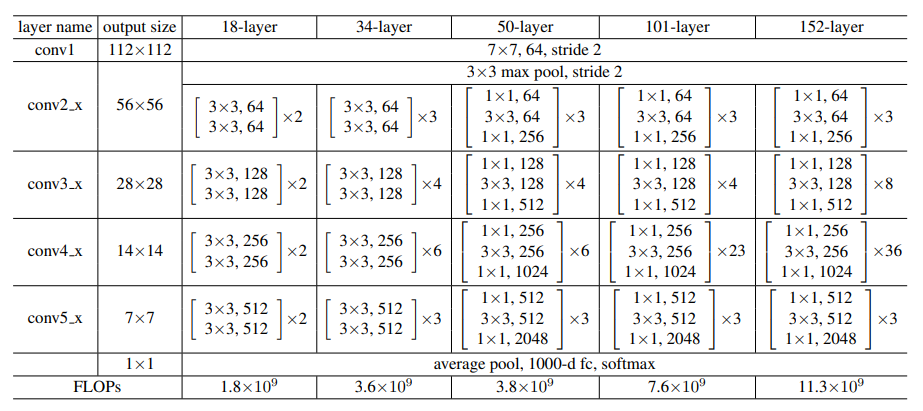1. ResNet理论
论文:https://arxiv.org/pdf/1512.03385.pdf
残差学习基本单元:
在ImageNet上的结果:

效果会随着模型层数的提升而下降,当更深的网络能够开始收敛时,就会出现降级问题:随着网络深度的增加,准确度变得饱和(这可能不足为奇),然后迅速降级。

ResNet模型:

2. pytorch实现
2.1 基础卷积
conv3$ imes(3 和conv1) imes$1 基础模块
def conv3x3(in_channel, out_channel, stride=1, groups=1, dilation=1):
return nn.Conv2d(in_channel, out_channel, kernel_size=3, stride=stride, padding=dilation, groups=groups, bias=False, dilation=dilation)
def conv1x1(in_channel, out_channel, stride=1):
return nn.Conv2d(in_channel, out_channel, kernel_size=1, bias=False)
参数解释:
in_channel: 输入的通道数目
out_channel:输出的通道数目
stride, padding: 步长和补0
dilation: 空洞卷积中的参数
groups: 从输入通道到输出通道的阻塞连接数
feature size 计算:
output = (intput - filter_size + 2 x padding) / stride + 1
空洞卷积实际卷积核大小:
K = K + (K-1)x(R-1)
K 是原始卷积核大小
R 是空洞卷积参数的空洞率(普通卷积为1)
2.2 模块
- resnet34
- _resnet
- ResNet
- _make_layer
- block
- Bottleneck
- BasicBlock
Bottlenect
class Bottleneck(nn.Module):
expansion = 4
__constants__ = ['downsample']
def __init__(self, inplanes, planes, stride=1, downsample=None, groups=1,
base_width=64, dilation=1, norm_layer=None):
super(Bottleneck, self).__init__()
if norm_layer is None:
norm_layer = nn.BatchNorm2d
width = int(planes * (base_width / 64.)) * groups
# Both self.conv2 and self.downsample layers downsample the input when stride != 1
self.conv1 = conv1x1(inplanes, width)
self.bn1 = norm_layer(width)
self.conv2 = conv3x3(width, width, stride, groups, dilation)
self.bn2 = norm_layer(width)
self.conv3 = conv1x1(width, planes * self.expansion)
self.bn3 = norm_layer(planes * self.expansion)
self.relu = nn.ReLU(inplace=True)
self.downsample = downsample
self.stride = stride
def forward(self, x):
identity = x
out = self.conv1(x)
out = self.bn1(out)
out = self.relu(out)
out = self.conv2(out)
out = self.bn2(out)
out = self.relu(out)
out = self.conv3(out)
out = self.bn3(out)
if self.downsample is not None:
identity = self.downsample(x)
out += identity
out = self.relu(out)
return out
BasicBlock
class BasicBlock(nn.Module):
expansion = 1
__constants__ = ['downsample']
def __init__(self, inplanes, planes, stride=1, downsample=None, groups=1,
base_width=64, dilation=1, norm_layer=None):
super(BasicBlock, self).__init__()
if norm_layer is None:
norm_layer = nn.BatchNorm2d
if groups != 1 or base_width != 64:
raise ValueError('BasicBlock only supports groups=1 and base_width=64')
if dilation > 1:
raise NotImplementedError("Dilation > 1 not supported in BasicBlock")
# Both self.conv1 and self.downsample layers downsample the input when stride != 1
self.conv1 = conv3x3(inplanes, planes, stride)
self.bn1 = norm_layer(planes)
self.relu = nn.ReLU(inplace=True)
self.conv2 = conv3x3(planes, planes)
self.bn2 = norm_layer(planes)
self.downsample = downsample
self.stride = stride
def forward(self, x):
identity = x
out = self.conv1(x)
out = self.bn1(out)
out = self.relu(out)
out = self.conv2(out)
out = self.bn2(out)
if self.downsample is not None:
identity = self.downsample(x)
out += identity
out = self.relu(out)
return out
2.3 使用ResNet模块进行迁移学习
import torchvision.models as models
import torch.nn as nn
class RES18(nn.Module):
def __init__(self):
super(RES18, self).__init__()
self.num_cls = settings.MAX_CAPTCHA*settings.ALL_CHAR_SET_LEN
self.base = torchvision.models.resnet18(pretrained=False)
self.base.fc = nn.Linear(self.base.fc.in_features, self.num_cls)
def forward(self, x):
out = self.base(x)
return out
class RES34(nn.Module):
def __init__(self):
super(RES34, self).__init__()
self.num_cls = settings.MAX_CAPTCHA*settings.ALL_CHAR_SET_LEN
self.base = torchvision.models.resnet34(pretrained=False)
self.base.fc = nn.Linear(self.base.fc.in_features, self.num_cls)
def forward(self, x):
out = self.base(x)
return out
class RES50(nn.Module):
def __init__(self):
super(RES50, self).__init__()
self.num_cls = settings.MAX_CAPTCHA*settings.ALL_CHAR_SET_LEN
self.base = torchvision.models.resnet50(pretrained=False)
self.base.fc = nn.Linear(self.base.fc.in_features, self.num_cls)
def forward(self, x):
out = self.base(x)
return out
class RES101(nn.Module):
def __init__(self):
super(RES101, self).__init__()
self.num_cls = settings.MAX_CAPTCHA*settings.ALL_CHAR_SET_LEN
self.base = torchvision.models.resnet101(pretrained=False)
self.base.fc = nn.Linear(self.base.fc.in_features, self.num_cls)
def forward(self, x):
out = self.base(x)
return out
class RES152(nn.Module):
def __init__(self):
super(RES152, self).__init__()
self.num_cls = settings.MAX_CAPTCHA*settings.ALL_CHAR_SET_LEN
self.base = torchvision.models.resnet152(pretrained=False)
self.base.fc = nn.Linear(self.base.fc.in_features, self.num_cls)
def forward(self, x):
out = self.base(x)
return out
使用模块直接生成一个类即可,比如训练的时候:
cnn = RES101()
cnn.train() # 改为训练模式
prediction = cnn(img) #进行预测
目前先写这么多,看过了源码以后感觉写的很好,不仅仅有论文中最基础的部分,还有一些额外的功能,模块的组织也很整齐。
平时使用一般都进行迁移学习,使用的话可以把上述几个类中pretrained=False参数改为True.
实战篇:以上迁移学习代码来自我的一个小项目,验证码识别,地址:https://github.com/pprp/captcha_identify.torch